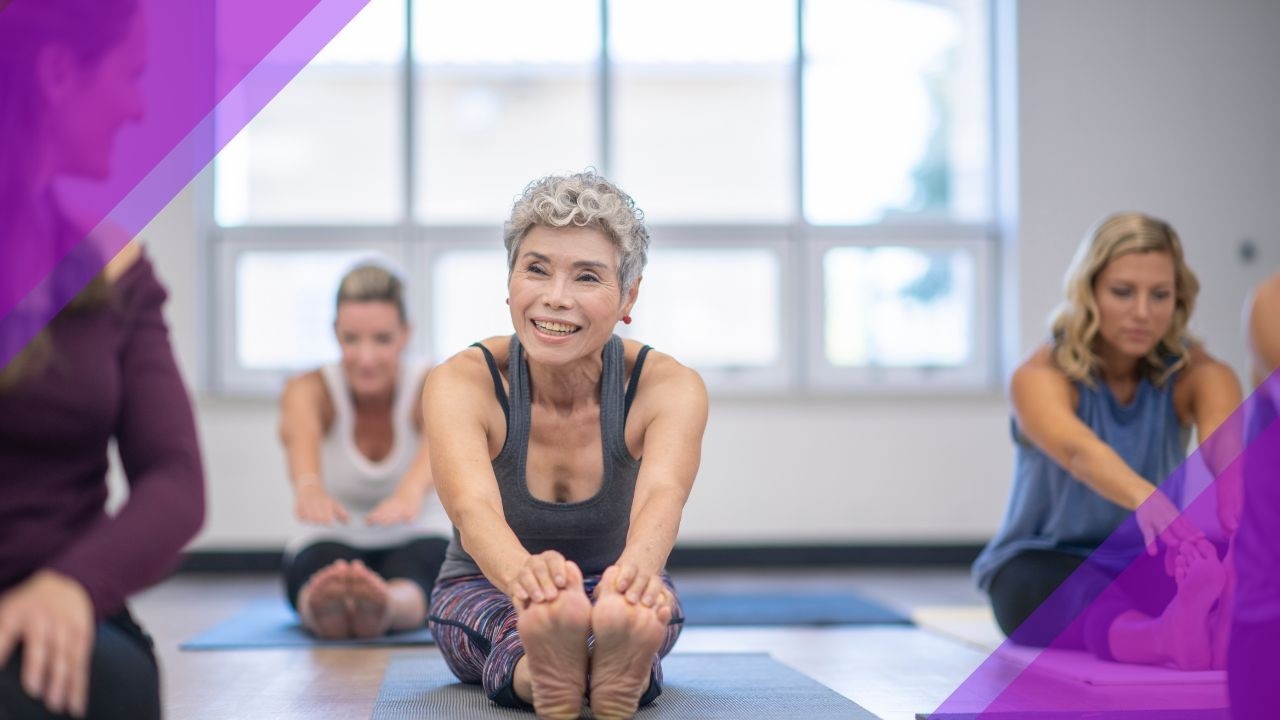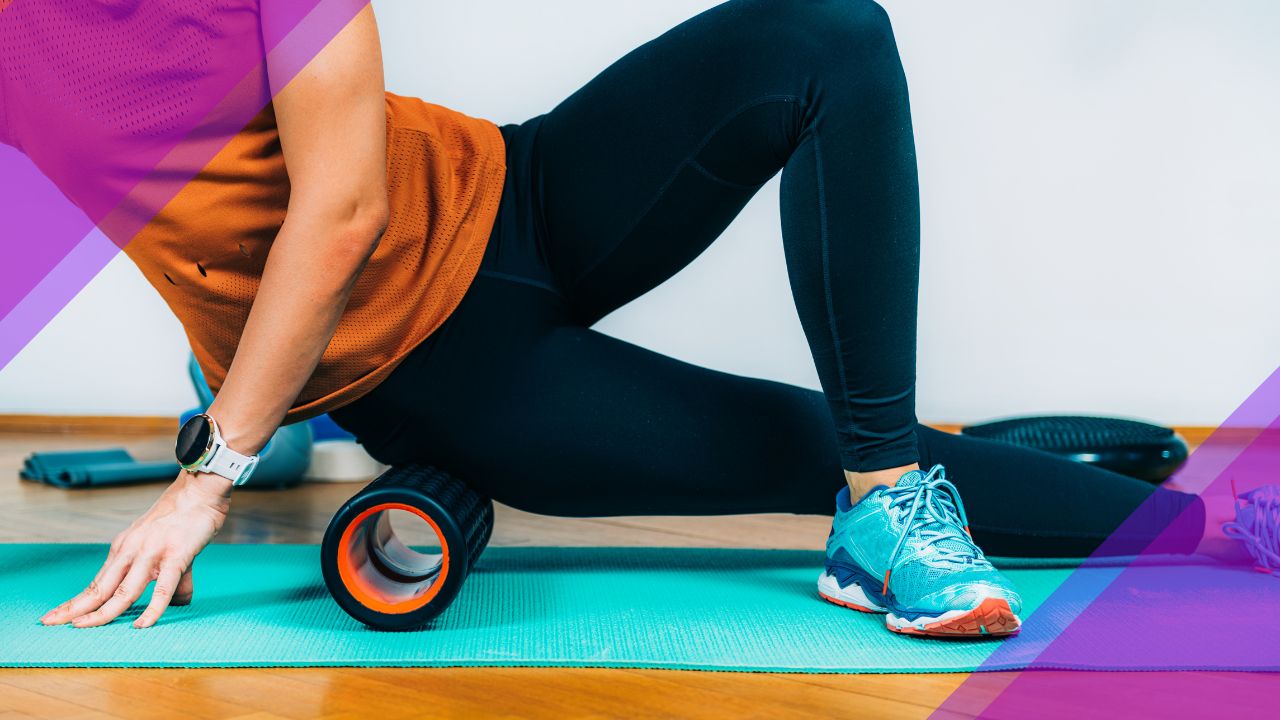
5 Easy Ways to Improve Mobility During Menopause
Aug 08, 2022The little things matter a lot when it comes to moving pain-free.
By Selene Yeager
Mobility is the foundation for a healthy, active life. Though we tend to conflate it with flexibility, mobility is more than being able to touch your toes or drop into a picture-perfect pigeon pose. It’s the ability to move your joints through their intended range of motion and control that movement with strength and stability. It’s the foundation that provides optimum athleticism and protection from injury. You also just feel great when you have good mobility.
Mobility can get compromised during menopause. Though scientists are still studying the exact mechanisms, hormone levels appear to have a significant impact on joint, muscle, and connective tissue health, explains Claire Callaghan, B.Pty, during Hit Play Not Pause episode 30 Train Smart & Avoid Injury.
“Estrogen has a positive effect on connective tissue health,” she says. That includes your ligaments, tendons, and fascia (the thin casing of connective tissue that surrounds your muscles). “As your estrogen declines, your ability to regenerate these tissues may be affected …we often see women presenting with more things like Achilles issues, hip pain, and plantar fasciitis issues in midlife,” she says.
Testosterone can enhance tendon stiffness and tendon collagen turnover. It also declines during the menopause transition. Plus, all the wear and tear we’ve accumulated over the years just starts to add up at this time of life, as do any imbalances and bad habits.
The Pinball Effect
When mobility breaks down, so does your functional movement. Poor ankle mobility, for instance, can impair your ability to flex and extend your foot, which can be detrimental to your running form and pave the way for strains and injuries like Achilles tendonitis and shin splints. It also makes it hard to perform a squat with the proper distribution of weight on your forefoot, causing you to compensate by rounding your back or pushing your shoulders too far forward to get the weight where you need it to be, increasing your risk for injury.
A lack of mobility in one place, like your shoulder, can have a pinball effect as your body compensates, causing pain in a completely different and seemingly unrelated place. It also can slow you down in unexpected ways. Tight shoulders, for instance, can restrict a runner’s arm pump. So you may be swinging your arms to pick up the pace, but instead of moving front and back to propel you forward, they’re criss-crossing your body, which wastes energy rather than generating speed.
If you find yourself with a slew of injuries and niggles, a movement assessment by a physical therapist is in order. They can assess your movement patterns and help you improve your mobility and reduce your risk for injury.
But everyday self-care habits and movements matter, too…a lot. Dr. Kelly Starrett of The Ready State and author of the New York Times bestseller Becoming a Supple Leopard explained some everyday ways we can stay in the game during Hit Play Not Pause episode 23 Ease Your Aches & Pains. Here’s what he recommends:
Work Out the Kinks
You want to work out any kinks, knots, and stubborn spots that restrict your movement. You can do this with one of those percussive therapy massage guns like the Hyperice Hypervolt or Theragun. Or you can use a lacrosse ball and foam roller. The goal is to break up adhesions and scar tissue within the muscle and fascia to reduce stiffness and tension and increase blood flow.
In general, balls work best for small areas like the foot and shoulder blades, as well as for targeting specific spots anywhere on your body. Rollers are good for broad muscles, especially on the legs.
Once you have your implement of choice, compress and roll your muscles. Put your weight on top of the ball or roller and slowly roll your muscle over it, working out the tight spots. With a ball, you also can work side to side and/or in circular motions. According to Starrett, and contrary to popular perceptions, this should not hurt.
Starrett explains further, that if you lie on a lacrosse ball or foam roller and it hurts, those tissues aren’t gliding correctly. Normal, healthy muscles shouldn’t hurt during compression.
That said, you’re bound to feel some discomfort because most of us have knots and adhesions (which is why we’re doing this). The most important rule when using these massage tools is that you should be able to breathe fully and deeply while using them. If you press so hard that you have to hold your breath, you’re going too deep and triggering your fight-or-flight response, which will only exacerbate the problem. Press into the roller or ball with just enough pressure that it’s slightly uncomfortable, but not painful. This will send a signal to the central nervous system to reduce tension, which relieves soreness and improves range of motion.
Over time the goal is for these massage sessions to be minimally uncomfortable. That means your tissues are operating with healthy mobility and don’t perceive a threat when they’re under tension. This also should ease joint pain because the muscles around those joints are no longer under dysfunctional amounts of tension.
To work out stubborn spots, add some deep breathing and isometric contractions — a technique Starrett swears by.
- Press into it with the ball or roller (again, just to discomfort).
- Take a deep, full inhale for four seconds, drawing the breath all the way into your belly.
- At the top of the inhale, isometrically contract the muscles around the ball/roller for four seconds, squeezing hard.
- Then slowly exhale for eight seconds while relaxing your muscles around the ball/roller.
- Repeat that cycle three or four times on the sore spot.
The deep breathing activates your parasympathetic nervous system and the isometrics tell your brain it's okay to generate force on that spot, Starrett says. “It resets the signal and helps your brain perceive the tissues as safe and desensitizes painful tissues.”

Sneak in Short Walks
As much as we exercise, many of us are “active couch potatoes”--people who train regularly, but then sit at desks, in cars, in meetings, and so on for much of the day. That’s bad for your health, as well as your mobility.
“You need to move to pump your lymphatic system,” says Starrett, who likens the lymphatic system to your body’s sewer. It’s where your body accumulates much of your metabolic waste. But unlike your circulatory system, which is in constant motion thanks to your heart, your lymphatic system is powered by your skeletal muscles. You can really only take out the trash by moving your muscles. That’s one of the many reasons health experts implore you to stand up and move around at least once an hour.
Walking is a very good healing exercise. It helps decongest your lymphatic system, stretches out your muscles, and keeps your joints lubricated. Sneak in short walks throughout the day whenever possible.
Get Down on the Ground
Kids and young people readily plop down on the floor, kneeling, legs crossed, like a pretzel, and/or in all sorts of configurations. We stop doing that in adulthood and then it gets progressively harder to get down on the floor and back up again because unless you do yoga or other mat exercises regularly, you’re rarely if ever, taking your body through that full range of motion of dropping all the way to the floor in a controlled manner. That’s really important, explains Starrett.
“Sit on the floor while you watch TV. It’s an easy way to get a ton more movement variety,” he says. That level of mobility is also an extremely important life skill and strength to have with age.
Work More Dynamically
If you have a largely sedentary job, Starrett says to shift your workstation to be more dynamic, so you can sit and stand and change positions frequently. Then when it’s time to workout, your engine is already primed and idling. “You don’t have to cold start it and maybe bring in the jumper cables, because you’ve been stuck in park for hours,” he explains.
Warm Up in the Morning
You likely already appreciate the benefits of a proper warm up before starting a run, ride, lifting session, or other physical pursuit. But if that’s all you do to prepare your body for your daily activity, it’s kind of like cramming before the exam, explains Starrett.
Spending 8 to 10 minutes in the morning going through a movement session, like Sun Salutations, a Foundation series, or Starrett’s morning routine, can open up the system and set the stage for good movement for the rest of the day.
Get Feisty 40+ in Your Inbox
We hate SPAM. We will never sell your information, for any reason or send you emails that suck!


